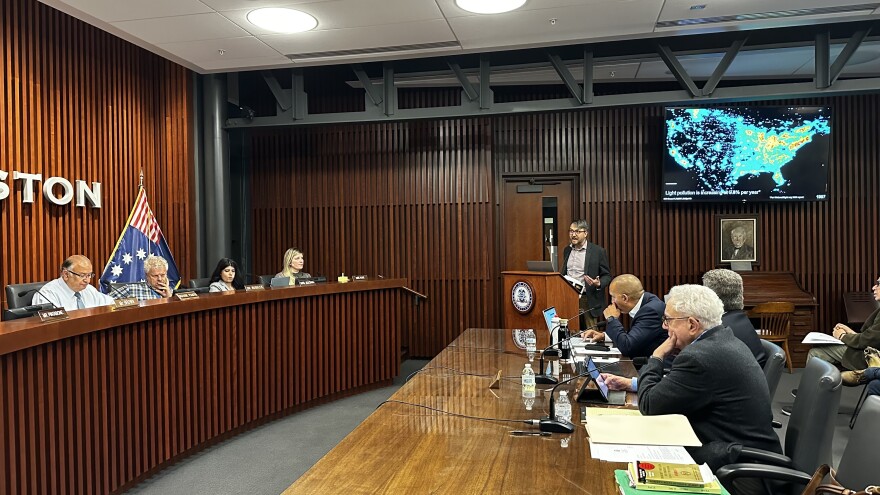EASTON, Pa. — Easton City Council this week got a fresh look at how it can improve the lighting situation in the city — a hot topic as it continues to work on streetlight replacements that have caused some tension with residents.
Environmental Advisory Committee Chairman Nick Gorski was joined by Sustainability Coordinator Brandon Sullivan on Wednesday to offer a presentation on Dark Skies to council.
“It is bad for both animals and humans to have light that is shining this late at night. We want to see the actual sky stars at night, rather than just reflected light from all of the streetlights and other things that happen within our city."Environmental Advisory Committee Chairman Nick Gorski
They urged the board to consider adopting an ordinance that could help combat light pollution and improve health for humans and animals.
According to Gorski, light pollution has increased sharply across the country, especially in the Northeast.
As populations boomed in New York City and Philadelphia, Easton and the rest of the Lehigh Valley became brighter, as well, he said.
“It is bad for both animals and humans to have light that is shining this late at night," Gorski said.
"We want to see the actual sky stars at night, rather than just reflected light from all of the streetlights and other things that happen within our city."
The question is, how can the city and the EAC turn down the lights without sacrificing safety?
'Intelligently and strategically'
Gorski stressed that Dark Skies is not an initiative to eliminate all lighting in the city, of course.
“It is about using light intelligently and strategically throughout the city," he said.
"So this is shifting from incandescents to LEDs. It's using shielded fixtures that devote the light that gets emitted down, as opposed to out into the sides.
“There's multiple benefits when we're talking about dark sky lighting. It is strategic, it is intelligent, but it also still benefits us in a time where budgets inflate and get drastic."Sustainability Coordinator Brandon Sullivan
“And it's using temperature range limits to keep lighting around where an incandescent was.
"So 2,700 Kelvin to 3,000 Kelvin, which is a warmer, redder light, as opposed to a bluer, more daylight light that can help make it difficult to go to sleep, or affect the diurnal patterns of animals.
"It's also about using intelligent placement and strategic dimming.”
Sullivan is working with the EAC on several issues, though the EAC pushed the Dark Skies idea themselves, he said.
With his assistance, Sullivan said, alongside the city, the EAC could potentially initiate a Dark Skies program.
“There's multiple benefits when we're talking about dark sky lighting," Sullivan said. "It is strategic, it is intelligent, but it also still benefits us in a time where budgets inflate and get drastic.
“When we start upgrading to LEDs, costs go down, and while there's initial investment, that's one way we can operationally reduce the cost of our municipality and help lift the load on taxpayers.”
'More efficient and effective'
Other benefits may include improved sleep and regulated circadian rhythms for residents, as lighting with lower temperature colors reduce bodily stress and improve mental health, he said.
“Every night we go outside, we're prone to these lighting systems above us, and they can disrupt these circadian rhythms over our lifetimes," Sullivan said.
"Leading to chronic illnesses like depression, diabetes, heart disease and even some forms of cancer."
Lighting also affects wildlife, Sullivan said, and brighter lighting can be detrimental to animals, insects and plants throughout the city.
Sullivan suggested technology such as dimmers could help limit light in the city as needed.
“Maybe you have two lights next to each other, or three lights in a row, all next to each other," he said. "Maybe that middle light doesn't need to be at full capacity all the time.
“It could even be put to 10 percent and you still have effective lighting from the light shining down on the other two surrounding the edges. It is just more efficient and effective.”
To make such changes, there is going to need to be collaboration, he said.
Sullivan stated his work with the EAC, along with Department of Public Works Director Dave Hopkins and other city officials have sat in on the Dark Skies subcommittee of the EAC, drafting ordinances on municipal lighting with a focus on new commercial construction.
In light of Met-Ed
As the Met-Ed replaces more than 1,200 lights across the city, Sullivan is working with it, as well, to ensure the use of Dark Skies compliant LEDs when possible.
Those individuals and organizations also are working on educational programming for residents, which they hope can address common concerns and questions when it comes to Dark Skies.
“I received more complaints on this issue than probably any other issue in my almost two years on council."Easton Councilwoman Crystal Rose
Such discussions come at just the right time, as Met-Ed has put a temporary stop to its light replacement program to coordinate with city officials to address concerns.
“I received more complaints on this issue than probably any other issue in my almost two years on council," Councilwoman Crystal Rose said.
"Recently Met-Ed installed some light bulbs downtown, light fixtures and streetlights, and the block I live on happens to be part of that footprint, and the outside of my house looks like a highway onramp.”
Rose said Sullivan, Hopkins and more are working on the issue.
Sullivan explained one of the key issues with the Met-Ed switch was the fact that the city had not been informed about a project start date.
“But as of now, we're at that point where we're going to pause it, adjust, observe and adjust again,” Sullivan said.


